
“If I hold a twenty pound weight, I cannot detect a fly landing on it because the least detectable difference in the stimulus is half a pound. On the other hand, if I hold a feather, a fly landing on it makes a great difference. Obviously then, in order to be able to tell the differences in exertion one must first reduce the exertion. Finer and finer performance is possible only if the sensitivity, that is, the ability to feel the difference is improved.”
Moshé Feldenkrais
During my training to become a Feldenkrais Practitioner I learned of the Weber-Fechner law. The law proposes there is a relationship between the magnitude of a physical stimulus and the intensity or strength that people feel or sense.
In an Awareness Through Movement class or individual lesson with a Practitioner (Functional Integration lesson) we often start by lying down to sense our body in stillness and comfort. With small, slow and gentle movement, that is, a very gentle stimulus, we learn something about the resting position and length of our muscles. When moving at this pace we are more able to sense differences. It may be possible to notice an unnecessary lift of the head, tightening of belly muscles, or breath hold. This extra effort interferes with smooth coordinated action. When moving quickly in a habitual or familiar way the opportunity to learn is missed.
When given time to track and sense movements our nervous system is more able to notice differences. The nervous system loves looking for efficient ways of doing things. This is one of the reasons we develop habits. Some habits are very useful to us, and some are not. Learning to make distinctions around the sensations of movement allows the nervous system to respond in a different way. When our ability to make finer sensory distinctions improves then our ability to sense unnecessary effort improves.
A simple thing to explore right now is to observe your breathing. Can you track the pathway of the air as it is drawn in, through the nose past the back of the mouth and along down through the throat? Where does it flow to? Notice what parts of your body move as the breath comes in, and out. Track this for a few breaths in and out.
If you clench your fist, or contract some part of your belly observe how this affects the flow of the breath in and out. Sense the difference between having your feet placed comfortably on the ground compared to feet hanging because you are sitting on a chair that is too high. You may notice that breathing is not as easy or pleasant. This is one simple example of how unnecessary effort affects movement. Clenching your fist or holding in your belly is creating resistance. Without feet having support from the ground there is effort in the body to seek support elsewhere. It requires energy to do and energy to overcome.
Recognising habits and the subtle ways we hold tension in ourselves can be difficult to detect. Similarly, there may be ways we create resistance throughout the day and we remain unaware. For example, that to and fro indecision we have when avoiding an awkward meeting, or conversation we really need to have. Procrastinating over the vacuum cleaning is another one. Notice the times when the jaw is clenched, the breath or belly is held because there is something we need to say but can’t. What a relief that sigh brings.
This all takes effort. The more sensitive you are to how you move the easier, more efficient and effortless movement becomes. Moshe Feldenkrais said that only when we sense how we are uselessly efforting can we begin to allow ourselves to stop.
“In order to recognize small changes in effort, the effort itself must first be reduced. More delicate and improved control of movement is possible only through the increase of sensitivity, through a greater ability to sense differences”. Moshé Feldenkrais
Moving with this awareness gives us the ability to organise easy, powerful and healthy activity.
The 6-week series of classes from November 14th to December 23rd will focus on improving our ability to make distinctions around the sensations of movement, noticing when we use effort that is not required for a movement, and how we can incorporate this every day.
See the class details for the upcoming November series. Please contact me if you have any questions or would like to make a booking.
